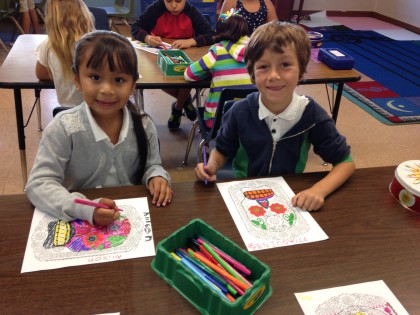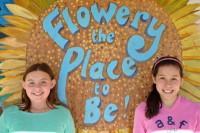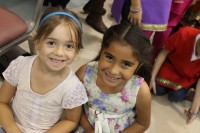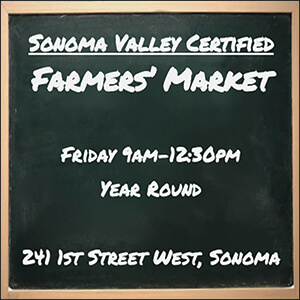A Flowery Outlook — Fully engaged in dual immersion

By Anna Lowe Pier | For The Sun
The quiet unassuming façade of Flowery School, located off the beaten track of Highway 12 in the Springs, gives no hint of the exciting academic and social experiment taking place within. Flowery is a dual immersion school, where every student is becoming bilingual and literate in English and Spanish.
Justina Montano, currently Testing Coordinator and part-time teacher, and parent of two children who have completed the program K-8, radiates enthusiasm. “I love the community. How the program breaks down barriers. I love not having to teach kids to be good to each other, to be open-minded.” Replying as to what she believes creates this positive environment, she said, “because everyone knows a language and is learning a language.” She added, speaking about the upper grades language arts class she teaches, “These children have learned not to judge each other.”
Longtime Flowery teacher Lucía Chávez-Goodman affirms that her students are “very accepting of cultural differences, very empathetic.” Chávez-Goodman, who herself came to Sonoma from Mexico when she was in third grade, pointed out that students at Flowery acquire their second language naturally, hardly noticing that they are learning it. Her three children have all finished the Flowery program.
 Kristina Reguero-Garrison, in her 10th year teaching in dual immersion at Flowery, told The Sun that teachers at Adele Harrison and the high school say they can spot Flowery kids, “for their good interpersonal skills, working with everyone.” Principal Esmeralda Sanchez Moseley says the most wonderful thing about her job is “when I walk into a class and see the kids genuinely engaged, supporting each other in their language learning.” Her overarching goal for Flowery is that “we are truly preparing our students – academically, socially and emotionally – to become what they want in life.”
Kristina Reguero-Garrison, in her 10th year teaching in dual immersion at Flowery, told The Sun that teachers at Adele Harrison and the high school say they can spot Flowery kids, “for their good interpersonal skills, working with everyone.” Principal Esmeralda Sanchez Moseley says the most wonderful thing about her job is “when I walk into a class and see the kids genuinely engaged, supporting each other in their language learning.” Her overarching goal for Flowery is that “we are truly preparing our students – academically, socially and emotionally – to become what they want in life.”
Moseley, who was raised in a Spanish-speaking home, was in business school at Santa Clara University, working for Apple, when she realized she wanted to be a teacher. She has taught in all models of bilingual education, and considers that here at Flowery she is “at the Mecca.” Moseley said one of her biggest challenges is recruiting teachers. One great success story is Osvaldo Rubio, fifth grade teacher who came to Flowery after teaching 12 years in a different immersion model. Rubio praises the school, its program, and its staff, “especially our leader.”
So what is “dual immersion” and how did it come to Flowery? As the population of children whose first language was Spanish burgeoned in schools all over California in the ‘90’s, teachers scrambled to find ways to serve these students. Research was showing that it was critical to provide content instruction in a child’s first language during the long process of mastering English, so many programs delivered core curriculum in Spanish. In Sonoma, Flowery, El Verano and Sassarini all implemented primary language teaching. But often the students in these programs all over the country had trouble integrating – socially and academically – when they entered English-only programs in a few years.
 The cutting edge solution was a Canadian model, “two-way immersion.” Windsor, Healdsburg and Napa had all implemented this program, borrowing from our neighbors to the north to meet the needs of our new neighbors from the south. Longitudinal research was showing that native Spanish speakers in this program finished 8th grade scoring as well and better in English than their peers in English-only programs. And they had maintained their home language. And it offered the exciting opportunity for native English-speaking children to become bilingual too.
The cutting edge solution was a Canadian model, “two-way immersion.” Windsor, Healdsburg and Napa had all implemented this program, borrowing from our neighbors to the north to meet the needs of our new neighbors from the south. Longitudinal research was showing that native Spanish speakers in this program finished 8th grade scoring as well and better in English than their peers in English-only programs. And they had maintained their home language. And it offered the exciting opportunity for native English-speaking children to become bilingual too.
In the fall of 1998, supported by a large federal grant, a kindergarten class with a balanced number of English and Spanish speakers was enrolled, who would all begin their formal schooling in Spanish! Eventually dual immersion became school-wide at Flowery, and the SVUSD designated it a “school of choice”, giving opportunity for parents from all over the district to enter their children in a lottery to enroll. Children living within the Flowery attendance district have preference.
The main elements of the program are: class enrollment is balanced 50/50 by home language. In kindergarten and 1st grade, 90 percent of the instruction is in Spanish; 80 percent in 2nd, and by 4th grade, 50/50 English and Spanish. Participants complete the full model at Adele Harrison. Data gathered by the Dual Immersion Task Force created by Superintendent Louann Carlomagno two years ago shows that the English learners are indeed faring as well or better than their peers in other programs.
So what do the parents say? For Brooke Cheeseman, with two boys in the school, “Flowery attracts a dynamic staff who thinks outside of the box, is dedicated to exploring new ways of teaching and getting children to learn.” She also noted that she sees that this program is very “age-appropriate,” meaning that the children are not under pressure to grow up too fast.
Allison Smith, 3rd grade parent, said: “ I think the first challenge of having kids at Flowery if you are not bilingual yourself is taking the leap of faith you will be able to understand what is going on, help your child with homework.” That has all worked out and Smith exclaimed, “We wouldn’t want to be anywhere else!”
Gilberto Suástegui said he chose Flowery so his children could keep communicating with their family. He has seen Hispanic parents suffer when their older children are barely able to communicate with them in Spanish, so they hardly connect. And Edith Cortez said she wished her children to keep Spanish, “because it belongs to them” — but also be fluent in English, the land where they live.



